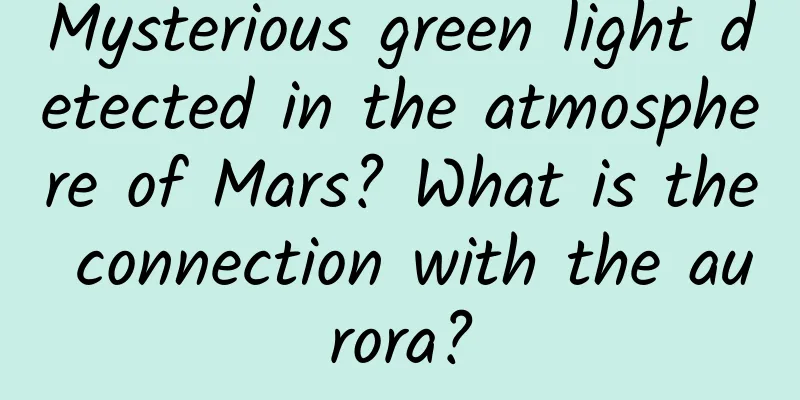Mysterious green light detected in the atmosphere of Mars? What is the connection with the aurora?

|
Astronomers detect a fascinating green glow in Mars' atmosphere Artist's impression of the Martian airglow. (ESA) Astronomers have detected a fascinating green glow in the Martian atmosphere, and it is produced by a process very similar to the air glow on Earth. When solar radiation hits the Martian atmosphere, it breaks carbon dioxide into carbon monoxide and oxygen. It is the oxygen atoms that are responsible for the green glow. Earth's airglow Previously, this glow had only been detected in the sky above Earth. Its discovery in the Martian atmosphere will help us better understand the processes that cause air glow on Earth and elsewhere. "The brightest light seen on Earth is the night glow. More specifically, a particular wavelength of light emanating from oxygen atoms that has never been found on any other planet," said Jean-Claude Gerard, an astronomer at the University of Liège in Belgium and lead author of a new paper describing the phenomenon. The Earth's sky is never completely dark, not even in the middle of the night, even after light pollution, starlight and diffuse sunlight have been extracted. Molecules in the atmosphere are constantly undergoing different processes that cause them to glow faintly across a range of wavelengths. Earth's Aurora This light is not entirely different from the aurora, as they are both produced by the same particles - except it is dimmer and the mechanism behind it is different. The aurora is emitted by charged particles produced by the solar wind, which ionizes atmospheric atoms, causing them to form flashes of light in the sky. Airglow, on the other hand, is caused by the interaction between sunlight and the atmosphere and can be roughly divided into two categories. Nightglow: When atoms are broken down by solar radiation during the day, excess energy is released in the form of photons. Nightglow has been observed on Venus and Mars, as well as on Earth. Venus's airglow What astronomers are observing now in the Martian atmosphere is dayside airglow — a phenomenon that is much harder to detect because its faint presence far outweighs daylight. On Earth, it only appears when molecules in the atmosphere absorb sunlight, which gives them more energy, causing them to emit it as radiation at the same or slightly lower frequency than what was originally absorbed. In images taken by the International Space Station (ISS), airglow is more obvious when the camera is looking through the top of the atmosphere rather than directly down. Scientists have suspected that airglow on Mars appeared in 1979. But Mars orbiters facing directly at the Martian surface have not detected it until now. Earth's night glow. (NASA) So, learning from the ISS, the team reoriented the nadir and occultation instruments on the Mars Discovery Orbiter (Nomad) from a position directly facing Mars to one looking through the atmosphere at the Martian horizon. From this position, they made a series of observations of the Martian atmosphere at altitudes ranging from 20 to 400 kilometers (12 to 250 miles). Mars Discovery Rover (Nomad) When they analyzed the data, they found green rays in both optical and ultraviolet wavelengths in all of the daytime observations. "The radiation is strongest at about 80 kilometres and varies depending on the distance between Mars and the sun," explained planetary aeronautician Ann-Karin Vandal of the Royal Institute for Space and Aeronautics of Belgium. When the team simulated the process behind the emission, they found that it was produced by a process very similar to airglow on Earth. When solar radiation hits the Martian atmosphere, it breaks carbon dioxide into carbon monoxide and oxygen. It's the oxygen atoms that are responsible for the green glow. Interestingly, the visible wavelength of this light is 16.5 times longer than the ultraviolet wavelength. "The observations at Mars agree with previous theoretical models, but are inconsistent with the actual glow we find around Earth, where the visible emission is much weaker," Gerard said. "This suggests that we need more time to understand how oxygen atoms react, which is very important for our understanding of atomic and quantum physics." The team suggests that the discrepancy could be a problem with the way Earth-observing instruments are calibrated. Obviously, the best approach is to do more science. The research has been published in the journal Nature Astronomy. by: Josh K. Elliott FY: Skylee If there is any infringement of related content, please contact the author within 30 days to delete it. Please obtain authorization for reprinting, and pay attention to maintaining integrity and indicating the source |
<<: Do animals sleep well? They sleep standing up, hanging upside down, with their eyes open...
>>: Understand "International Customs Day" in 80 seconds!
Recommend
Just bite me, why are you buzzing at me?
Review expert: Mo Jianchu, Professor of Institute...
Foshan shared power bank mini program has customized functions. How much does the shared power bank mini program cost?
With the advent of the 5G era, the network speed o...
An earthquake occurred in the Yellow Sea late at night. Don’t believe these statements about earthquakes!
According to the official Weibo of the National E...
Why are curved screen phones so common, but many people still prefer flat screen phones?
Curved screen is a very popular screen design on ...
5 Conversion Rate Optimization Strategies for SaaS Products!
For the conversion rate of SaaS products, every o...
AI beats human champion again! This time, in drone racing
Artificial intelligence (AI) has once again defea...
WWDC celebrates its 30th anniversary. Will iOS and macOS finally be connected?
This article is reproduced from Leiphone.com. If ...
My Brand Methodology
In this article, I want to summarize the "br...
2020 Short Video E-commerce Live Streaming Operation Plan Practical Tips
A quality live broadcast must be carefully planne...
Tomatoes are becoming less and less tasty. Is it my illusion? You will understand after reading this!
If you still remember the tomatoes you ate as a c...
What is Web Hosting? What are the advantages and disadvantages of shared hosting?
After the website is completed, where should it b...
Operation and promotion: Thoughts on the 3-fold growth of App users
Scenario—Creativity—Benefit Point—Cycle—Channel, ...
iOS 8.3 makes some users unable to use Touch ID payment function
[[131544]] On April 10, according to foreign medi...
Official reminder! Be careful when eating this kind of rice noodles recently, as it may cause death!
Expert of this article: Fu Shufang, Master of Foo...
Do you like to eat cold dishes in summer? Be careful! Eating these vegetables raw can easily lead to parasite infection!
In the hot summer, the weather is getting hotter ...








![The estimation tool can estimate the following data [Baidu bidding]](/upload/images/67cc3038820e5.webp)
